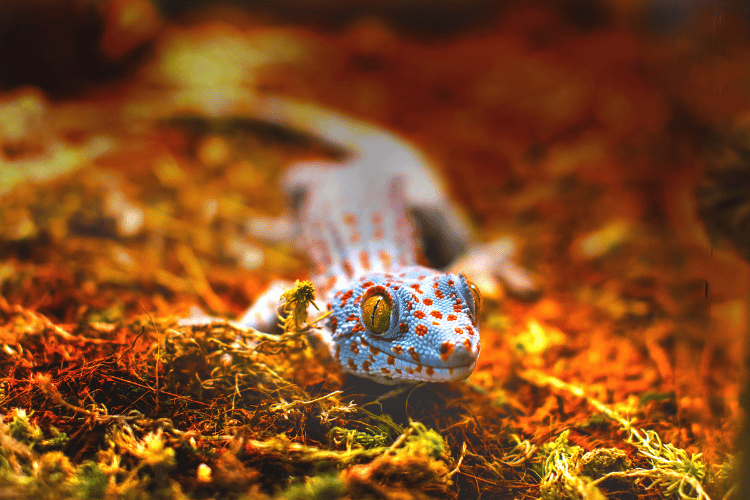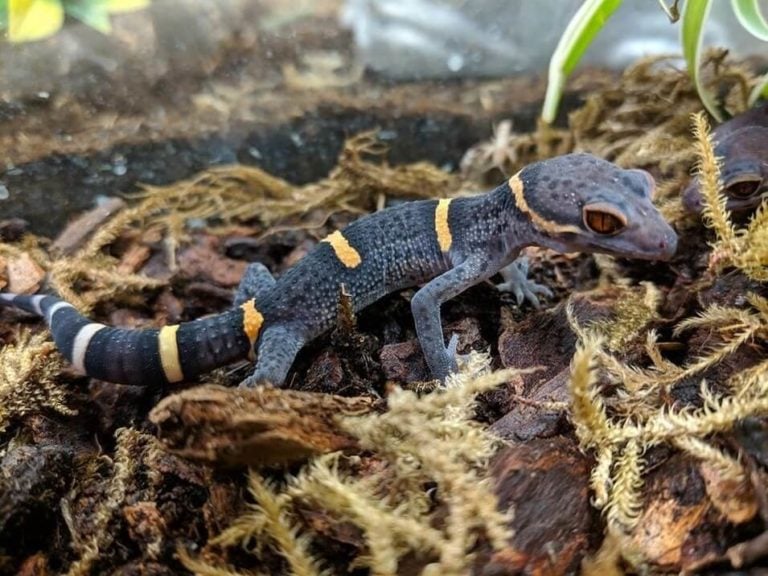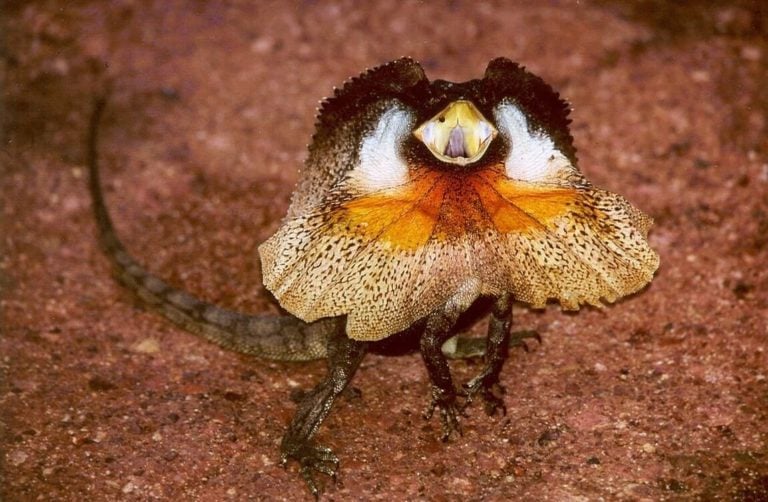Tokay Geckos are best known for their bright colors and excitable temperaments. Native to the hot, humid forests of Southeast Asia, these feisty reptiles get their names from the ‘to-kay’ sound they make during mating.
Even though they’re not big on being handled, their general care is pretty low-maintenance, including their breeding.
In this post, we’ll tell you all about breeding tokay geckos. We’ll also give some handy tips on how to keep your tokays healthy and happy for years to come.
Let’s jump in.
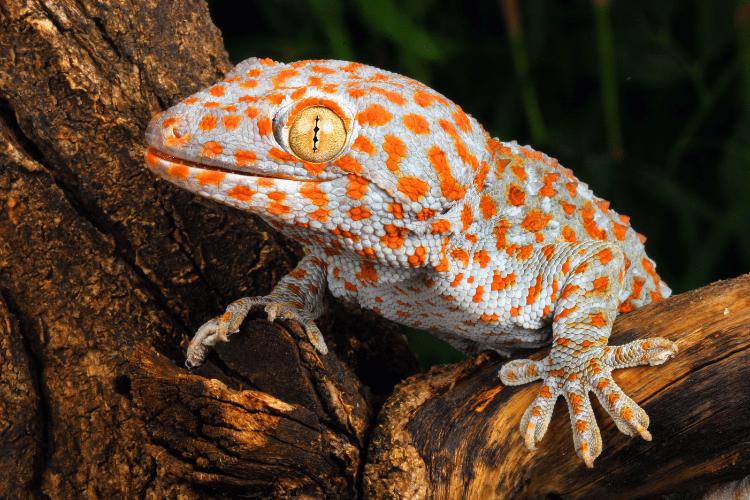
Breeding Tokay Geckos
Tokay geckos (Gekko gecko) are one of the easiest species of geckos to reproduce. Just allow them time to become used to their new environment, and they’ll take it from there.
Some captive tokays can produce all year, while others follow their natural seasonal breeding cycle.
Below is everything you need to know about breeding tokay geckos. Take a look.
Ideal Breeding Age
Ideally, male tokay geckos should be at least one year old before they can start breeding. Even if the gecko is ready physiologically, it’s preferable to wait until they reach their maximum physical development.
Some breeders choose to wait until the female is nearly two years old. It’s to ensure that she’s healthy and robust, thus capable of successful breeding.
The reason is that breeding takes a lot out of both the male and female. So, until they reach their full physical potential, it may have a long-term negative effect.
This is especially true for the female because she needs time to rest after each mating season to refortify her mineral reserves.
Without proper nutrition and rest, females can become malnutritioned, which can eventually lead to death.
In fact, coming in second place after dehydration, overbreeding has been determined to be a major cause of death of captive female tokay geckos.
The Start of the Breeding Season
For tokay geckos, the mating season usually starts in late October and runs until early June.
This is when the males can be heard calling out to females at night with their signature call of ‘to-kay,’ which is actually how they got their name.
The females, on the other hand, will begin to secrete fluids from their femoral pores as a way to attract males.
During this time, females will breed several times. Males have also been known to mate with multiple females throughout the breeding season.
The female typically lays two eggs nearly a month after mating and will continue to lay eggs approximately every 30 days for a total of about 6–8 days during the entire mating season.
Nest Conditions
Signs that the Gekko gecko female is about to lay eggs is that her appetite increases, but she’s still losing weight. She’ll also begin what looks like digging behavior even though tokay geckos don’t lay their eggs in the ground.
A tokay nest is typically a small opening between two solid vertical surfaces like a slate or bark. The female will lay the eggs and adhere them to this vertical surface about an inch or two apart.
After the female has laid the eggs, both parents keep watch over them until they hatch. They occupy either the top or bottom space of the nest, which is typically around 18–24 inches wide.
This should be enough to give room for both parents and the egg clusters.
Incubation
Believe it or not, by controlling the temperature of the incubation, you can control whether the eggs will produce males, females, or undeveloped eggs.
Even just a small modification in the temperature inside the tank can result in dramatic changes in the sex ratio of the newborns
In fact, this is one of the most unique things about a tokay’s breeding. Plus, the fact that this can only be done with only a few gecko species is even more impressive.
Studies show that when temperatures are kept at a steady 77℉, the majority of the eggs will produce female hatchlings. Alternatively, at higher temperatures, namely around 86℉, mostly males will hatch.
Anything too high or too low then these temperatures will result in undeveloped eggs. So, you need to regularly monitor the temperature and humidity in the tank to ensure they’re ideal.
As long as conditions are right, incubation should go off without a hitch.
However, there are incubators you can buy that provide a safer and more controlled environment for the eggs. You can also make your own incubator by laying some damp paper towels in a plastic container, making several holes in the lid, then covering it up.
It’s worth mentioning that if you remove the nesting area, the female is likely to stop laying eggs for the entire breeding season.
So, if you choose to use an incubator, make sure you prepare it and place it in the tank at the start of the mating season.
Tank Conditions
Gecko eggs feel more like malleable leather than hard calcium shell-like bird eggs. This allows for the eggs to expand as the tokay baby grows and develops.
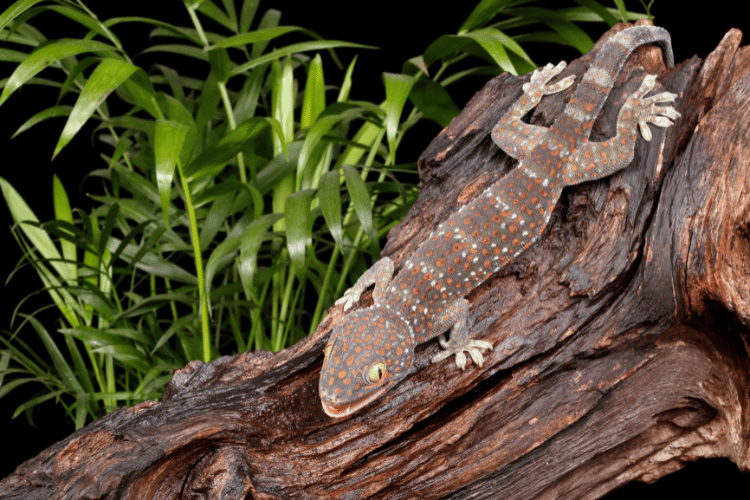
So, to ensure successful breeding, the tank needs to be kept at a constant level of high humidity.
The surrounding substrate should consist of coconut fiber, peat moss, moist paper towels, or soft soil. It should be kept damp and soft to ensure the shells stay pliant while preventing them from drying out.
Unfertilized Eggs
You may be surprised to know that female tokays can lay eggs without mating with a male. Yet the eggs won’t be fertilized, which means no tokay hatchlings.
This would be a good time to dispel the theory that tokay males and females are prone to eating their own fertilized eggs.
They’ll usually only consume unfertilized eggs as a source of nutrition.
Yet, it’s worth noting that another female may eat the eggs of a different female. Also, if a male tokay gecko senses that there are eggs from a previous breeding with another male, he may eat them.
Both these scenarios are compelling reasons why you should never place more than one unrelated female or male in the same tank.
Tokay Hatchlings
Tokay gecko eggs take an average of 90–120 days to hatch, depending on the temperature of the incubation.
When they hatch, they’re typically around 2–3 inches long.
The first thing they do once out of their eggs is molt. Then, they eat their old skin for sustenance. It’s rich in minerals and nutrients and becomes the hatchlings’ main food source.
After that, these nocturnal hunters can start feeding on baby crickets or anything type of insect smaller than the size of their heads.
During the first month or so, both parents will care for and look after their newborns.
Then, after about 60 days, the hatchlings will become completely self-sufficient. This is when they should be transferred to their own enclosure before the adult male begins to nip at the juveniles.
Tokay Geckos Overview
Now that we talked about the specifics of breeding tokay geckos, let’s discover more about this fascinating species.
Origins
Tokay geckos are native to northeastern regions of India. They can be found specifically in the Indo-Australian Archipelago where there are plenty of tropical and deciduous forests.
Even though they prefer living in trees and can be highly territorial, these species are super adaptable and versatile.
Today, they’ve adapted to living in man-made environments in urban and suburban environments there’s no shortage of insects.
Appearance
Tokay geckos have a distinct look compared to the majority of other geckos because of their bright colors and big eyes. Their colors range from blue to bluish-gray with black or bright red spots.
The eyes on the tokay gecko are also bright and big with thin slits for pupils. One of their distinctive features is those big, bulging eyes that look like they’re almost jutting out of their heads.
The length of adult males ranges from 8 to 12 inches, whereas females can grow up to 13–16 inches.
Both males and females weigh an average of 140 to 200 grams.
Males are typically brighter in color while the females have a darker gray and brown base color. They also have cylindrical bodies with thicker, and more angular heads than the females.
Another way to tell them apart is to check for their line of pores. Located between their rear legs, the pores on an adult male are quite pronounced.
They form a V-shaped ridge with waxy protrusions.
Females also have these pores, but they’re not as obvious as the males.
Temperament
Tokay geckos may look adorable and harmless, but these highly spirited exotic animals aren’t for the faint of heart. They have a reputation for delivering nasty bites when they’re feeling threatened, agitated, or overly excited.
This is largely because they’re often prey to a larger, scarier creature. So, they’ve learned to defend themselves first and ask questions later.
Nevertheless, seasoned herpetologists say they tend to become calmer and less aggressive with regular interaction.
Still, they’re generally known to not be the best pet for handling. This is why they’re not suitable for beginners or even in a household where there are young children.
Habitat
As pets, they’re solitary animals that don’t get along too well with other geckos. So, be prepared to house your tokay gecko on its own except during breeding season.
Newborn hatchlings can be kept together. Yet, they should be relocated to a separate enclosure within six months after they hatch.
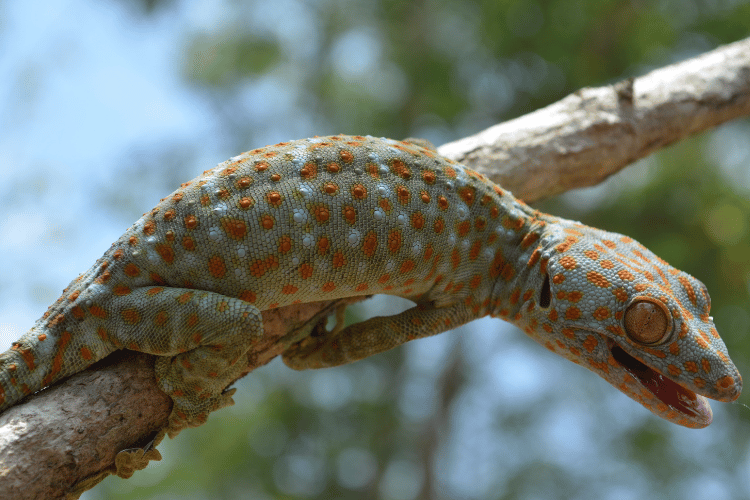
An ideal home would be a 30-gallon tank with a heat source. Glass tanks with lids are always best for geckos. The glass allows them to climb and explore their surroundings not only on the floor of the tank but also on the sides.
Tanks should also have plenty of hiding spots like bushes, rocks, and logs.
Tokays aren’t picky about the type of substrate you place in their tank. However, they prefer supple and spongy materials, such as soft wood shavings or paper towels. Just make sure you change it out frequently to prevent bacterial growth and avoid creating an unhealthy environment for your pet.
Heating and Humidity
Because tokay geckos thrive in tropical and sub-tropical climates, these reptiles do well in warm temperatures that range between 80℉ and 87℉.
Some people add an under-the-tank heater to make sure the temperature in the tank is hotter than room temperature by about 10%.
You can keep a thermometer in the tank to keep track of the temperature in the tank.
They also prefer high humidity levels of about 60% to 80%. You can achieve this by misting the tank each day.
Keep in mind that geckos have a hard time climbing wet surfaces. So, don’t forget to wipe down the tank walls after misting to make it easier for your gecko to climb.
Another trick is to place a damp towel over half of the top of the tank. This will keep the humidity without limiting airflow.
Lighting
Since this is a nocturnal species, tokay geckos don’t need a basking rock. They also don’t need artificial light conditions or a hooded lamp to light up the tank.
In fact, any type of artificial lighting can ruin the gecko’s circadian rhythm. This can later result in impaired physiological and metabolic functions.
They also don’t require a UVB light bulb. Just make sure that they’re given a dietary supplement that contains both vitamin D3 and calcium.
Feeding
The tokay gecko is relatively low-maintenance when it comes to its feeding habits. All it wants is to be left alone in its tank to mind its business without anyone invading its personal space.
As for food, the only thing these reptiles eat is insects. Yet, they’re not too picky about which insects they snack on. So, their meals can consist of anything like cockroaches, beetles, crickets, and mealworms.
Lifespan
Compared to other reptile species, tokay geckos are generally healthy and resilient. When given the proper care, tokays can live around 10 years in captivity.
The most important thing is to provide them with a balanced high calcium diet. A lack of calcium can lead to various health issues that can reduce their lifespan, such as metabolic bone disease.
Signs of a healthy gecko are if it hides during the day and becomes more alert and vocal at night.
Alternatively, if its movement is limited or doesn’t resist being picked up, it could be a sign that something isn’t right.
A Final Note
Compared to many other creatures, breeding tokay geckos is fairly straightforward. All they need is a well-maintained, stress-free environment and a place to lay the eggs.
You’ll notice that tokays typically lay multiple clutches of eggs, with each one containing an average of two eggs. Then, both parents will diligently care for the egg and the hatchling until it’s old enough to go off on its own, and the circle of life continues.

